Business
Seth Berger Leads Sixers Innovation Lab In Camden
Published
8 years agoon
By
Jie Kuang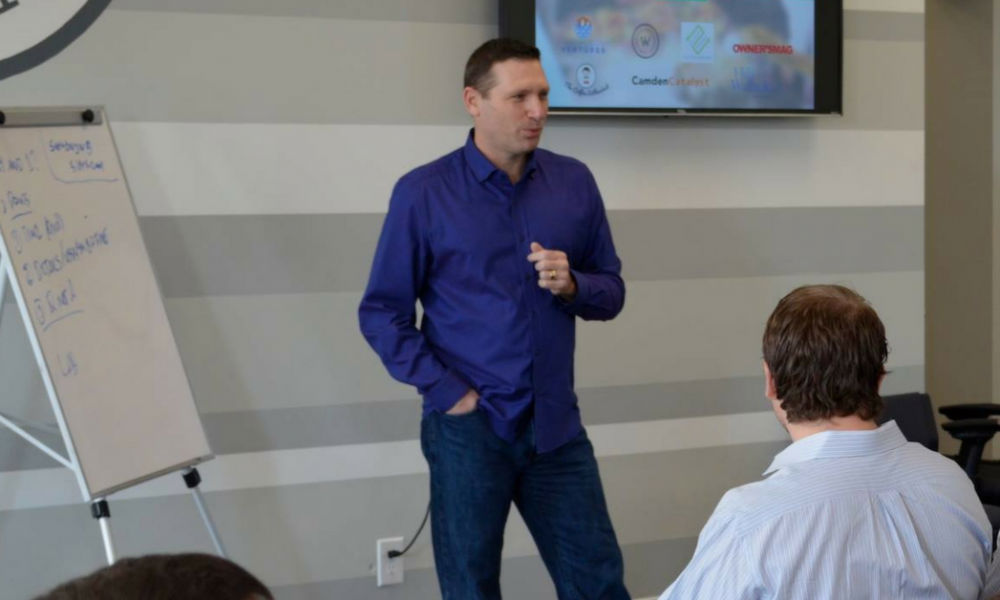
Entrepreneurs are flooding into Camden, including Seth Berger, University of Pennsylvania and Wharton School of Business alumni, best known as the Founder and former CEO of AND1. Seth Berger is managing the Sixers Innovation Lab Crafted by Kimball, which is housed in the Philadelphia 76ers Training Complex Business Operations Facility. Seth Berger has years of experience as an entrepreneur includes acting as a consultant and CEO in the gaming, technology and sports industry over the past decade. With a life long career in sports, Seth Berger provides opportunities for companies to grow using resources that are invaluable to business.
The Sixers Innovation Lab supports startups by providing individualized, industry-leading consulting and investment opportunities. Companies that are selected by Seth Berger and the Innovation Lab team will receive office space at the Innovation Lab, access to industry leaders, third-party branding, marketing and legal services, as well as free meals and housing in the Philadelphia area. There will also be unique opportunities to pitch to industry-leading investors and venture capitalists. Seth Berger is overseeing each startup that enters the facility along with advisors from StubHub, DraftKings, Rothman Institute, First Round Capital, Maven Creative and more.
With a unique set of skills and lifelong achievements in the sports industry, Seth Berger is passing on his knowledge on growing your company into something incredible. Seth Berger tells us about what it takes to be an entrepreneur today, making a lasting impression in business, and how you can be a part of the Sixers Innovation Lab.
Describe your career.
I started a business in grad school at 25, which is now known as AND 1. It started as a T-shirt company in NYC, where I am from. Then, in seven years it grew to a basketball apparel, sports illustrated company. I ran two companies at that time. In the middle of AND1, I also ran hoopstv.com and made all of the mistakes I could. Made a couple of deals with retailers, but ultimately sold AND 1 in 2005 to American Sporting Goods. My kids at that time were six, three, and one years old. The goal then was to just be super dad, take them to school, and to see them everyday. I had part time jobs, I didn’t want a full position. I managed a few companies along the way but, my career basically had three parts: running AND 1, coaching basketball at Westtown School, an independent international school, and consulting and advising at Innovation Lab. Working at Innovation Lab combined all of my skills as a coach, consultant, and CEO. As a coach, it helped me become a better consultant and CEO to help identify and recruit really talented CEOs.
As an entrepreneur, what are some surprises that come your way?
Whether I was running AND1 or the Innovation Lab, there were always surprises. I’ve never run anything before, so doing AND 1 and the Lab were the biggest surprises. I was never really good in school, I was only a good test taker. Memorization is the only skill I had and my biggest strength is admitting that I don’t know and I need help. That’s how I got so far. If you’re always curious, you’ll always grow.
From ‘93-’05, old businesses had to make a lot of guesses when it came to prices and consumers. Nowadays, with technology, you can test everything. You can have consumers telling you a price, likings, and etc.
I’m also really surprised with how fast things move now. Businesses would take three-five years to grow, now it can be successful in three-six months.
What are some of the risks you took to get to where you are?
When I decided to start AND 1, I was maxed out of student loans and lived off of five Visas. If AND 1 didn’t work out, the alternative was to take on a job that I didn’t like and find incredibly boring, nothing I looked forward to. I took a risk as in if it didn’t work, I was going to be really broke, but the thing was, I was broke anyway so I didn’t really care. The actual risk or the biggest risk for anyone is time. Time is your most valuable resource. My risk here at the innovation lab is can I help manage five to six companies at the same. I have the mentality of, ‘I think it’ll work.’ But if I spend three to five years here and it doesn’t work, it’ll be a really big waste of time. As an entrepreneur though, you’re comfortable with mistakes.
How do you make a lasting impression when you get into a new business?
By offering significant day to day support to our companies. If all of what you want is a check and a network, then there are lots of places to get that. In the Bay Area especially, there are tons of them but that’s not us. If you want help to figure out your business, what you do on a day to day basis or annual basis, then that’s what we provide.
What recommendations do you have to aspiring business owners?
Know your consumer really well and focus on them, one of the biggest mistakes in entrepreneurship is people who say, ‘I don’t want to focus on consumers in our market because then my business won’t be really big.’ I say to them, ‘Build a small business before you have a big business, it shows you already have a business, then continue to build and expand.’ With all of our companies, we end the day with these questions: Who’s going to watch our videos? Who’s going to use our service, buy our products and be as specific as possible with those answers?
Entrepreneurs who are thinking about starting versus entrepreneurs who have already started. Those who haven’t started aren’t afraid of failing because everyone fails eventually. It’s actually because they don’t know how to take charge. When you are your own CEO, it’s like getting a blank piece of paper for an essay but with no question. Everything is already set, what time you go into the office, the dress code, etc. with your business, no one is there to tell you. Don’t be afraid to get help.
What are some benefits the 76ers Innovation lab offer that can’t be found anywhere else?
I think Rhyan Truett, Innovation Lab Director of Operations, and I make a great team, along with Philadelphia 76ers CEO Scott O’Neil, and other people on our team can be really insightful for your business. We also offer free housing, free food, and free office space for about three months. In which there’s also access to free snacks and the gym. Also, we have a marketing agreement with strategy branding for companies, possible free legal services, and lastly, you can play basketball here.
How does startup apply for the opportunity to pitch?
Interested applicants can submit an application form through www.sixersinnovationlab.com.
What industries have you seen so far?
Everything, from cyber security, foot apparel, you name it. Our owner has a really broad network. If we can add value to your company then be let’s be a part, but if we can’t help you then it doesn’t make sense to apply.
Tips for entrepreneurs who are interested in being at Lab?
Always be willing to learn, companies who are in here are different from when they first came in. Be interested in improving. Companies who just need a check are not for us. There are three things we look for: first is what you take in, how smart, how focused, and how intense you are. Your team is a major aspect. For me, a team is the most important. I have members who studied in Wharton and are way smarter. Second, is the idea. Something you can protect and is unique. Lastly, how can we help you? If the company already had parts one and two, then how can we support you.
What is the piece of advice that helped you throughout your career?
In the fall of ‘93, when we were selling team shorts. I met Michael who owned a record company. He started his business by doing 45s. Back in the day, they used to do single records of songs of TV show songs like The Flinstones, The Munsters and all of the sudden his business blew up. He asked me, ‘Why do you want to be in business? Why do you wanna make a difference in kids’ lives?’ I said, ‘I think this business can reach kids and I can make a little money on the way, I also get to spend time with friends.’ He assured me then that you’re in business to make money, you’re not in it for your ego, you’re not in business to make friends, and you’re not in business to change who you are. And he was right. For awhile we thought we served kids as opposed to our consumers. When I got with our accounts, I asked, am I going to make enough and do I need more? If I bring in people who are around me and they get a piece of what I have or more, it’s okay. If you’re giving them pieces of yours, then they’ll eventually give more back to you. If you’re not giving your team a piece and think you have to be more in control, then it won’t work out. Like I said before, teamwork is the most important aspect of a business. Be willing to give.
Jie writes about influencers and startups in various industries. She is a designer turned techie, and when she is not writing, you can find her in her workshop working on her next big project.

You may like
Business
Top 10 Best Places to Buy a Mid Century Modern Office Chair
Published
2 weeks agoon
July 4, 2025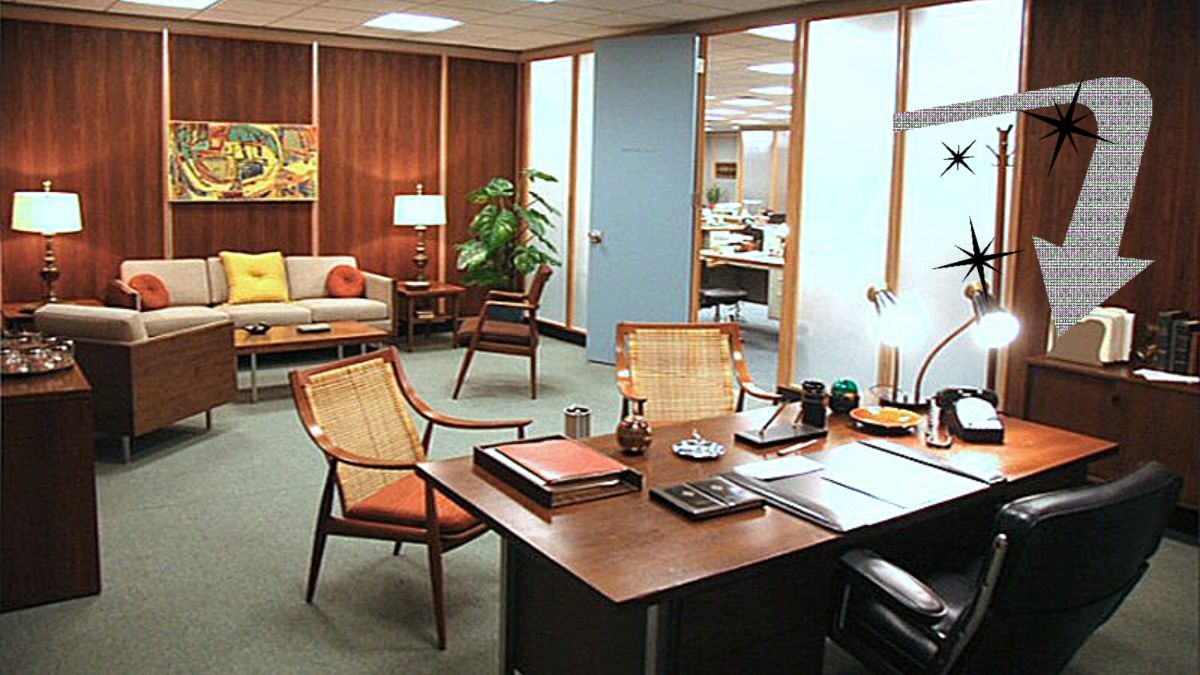
What was once old is new again: mid century modern is back in style. From architecture to furniture, the postwar look is in, and the hype extends all the way to office chairs.
Do you need a mid century modern office chair in your life? If so, there’s plenty to choose from. Your office chair should be tailored to your style, whether you like luxury, utility, or something in between.
That’s why we’ve put together our 10 favorite places to find your ideal mid century modern office chair.
What is mid century modern design?
After World War II, spirits were high in the US, and new technology was taking the country by storm. Mid century modern refers to the design concepts that came about during this time.
As opposed to the frilly, ornate designs of classical furnishings, mid century modern designs are angular, material, and functional. Wood is a common design element, especially teak. Mid century modern furniture may also have materials like glass, vinyl, and metal. Designs are simple and geometric, with bold accent colors to make them pop.
The mid century modern aesthetic never really went away, but it’s made a noted comeback in recent years. Some have chalked it up to Boomer and Gen X nostalgia, others point to mid-century-set shows like Mad Men and The Marvelous Mrs. Maisel.
Why should I buy a mid century modern office chair?
Mid century modern is the perfect fusion of style and utility. If you want to cultivate an office space that commands respect without being ostentatious, mid century modern is the style for you.
When it comes to office chairs, an MCM one is often made with sturdy wood and vinyl. They combine the ergonomics of a modern office chair with old-fashioned grace.
If you’re concerned with utility and utility only, a more bog-standard office chair may suit you. But a mid century modern office chair is great for someone who wants to wow colleagues with a mature, thoughtful business space.
Where can I get a mid century modern office chair?
1) Wayfair
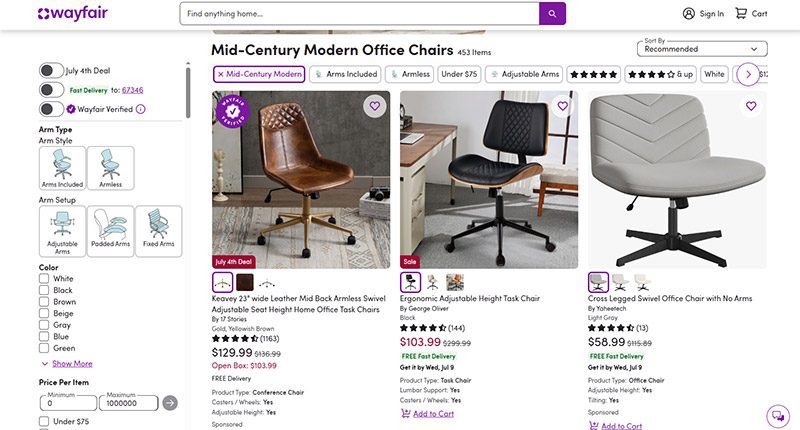
When it comes to furniture, Wayfair offers the best of both worlds. Their goods, including their mid century modern office chairs, are stylish and affordable. You can get a sturdy task chair for less than $100 or a more distinguished seat for less than $350.
MCM office chair examples: Dovray ($126), Bradford ($139), Lithonia ($133)
2) France & Son
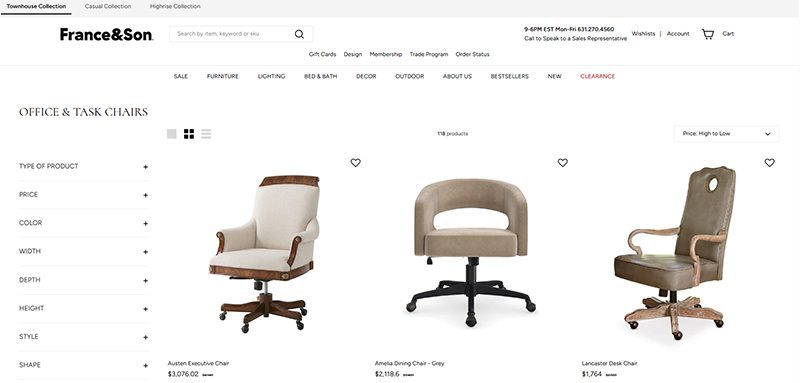
Wayfair’s chairs are affordable, but France & Son is the perfect option for luxury shoppers. Their mid century modern office chairs are robust and sleekly designed. If you dress to impress and enjoy the finer things in life, these are the chairs for you.
MCM office chair example: Brooks ($695)
3) Houzz
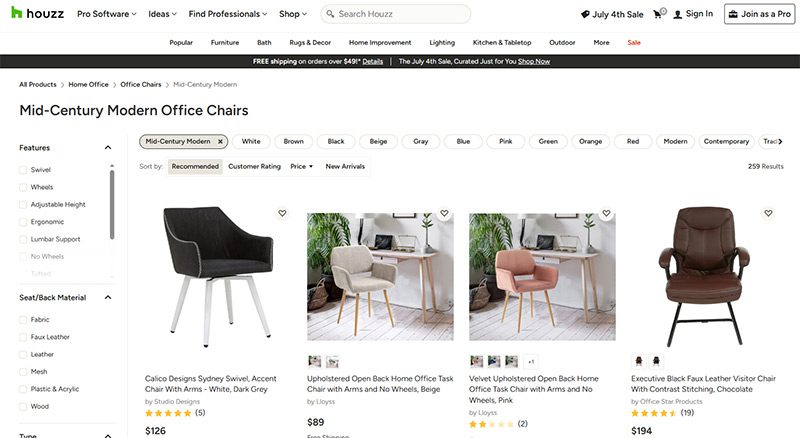
Started as a community for people to share home decor tips, Houzz has become a great ecommerce platform for finding stylish furniture. They’re more known for home decor than desk chairs, but they have plenty of great, affordable finds if you know where to look.
MCM office chair examples: Arvilla ($173), Rathburn ($259)
4) Laura Davidson
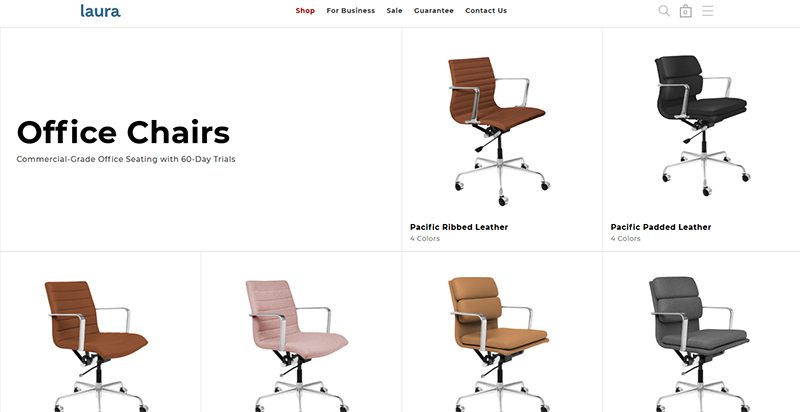
The Laura Davidson collection offers a fairly limited selection of classic office furniture. Still, there’s a reason they’re trusted by big-wigs like Apple, Disney, and Salesforce. Their chairs are sturdy and beautifully designed, reimagining classic Eames and Knoll designs.
MCM office chair examples: Rockefeller ($275), SOHO II Soft Pad ($450)
5) Icons of Manhattan

Icons of Manhattan has a simple philosophy: do one thing, and do it right. Their office chairs are handcrafted from premium materials and tailored to a mid-century modern style. If you want that Mad Men energy in your office (hopefully with a lot less angst), these are the chairs for you.
MCM office chair example: Ribbed Medium ($219)
6) Amazon
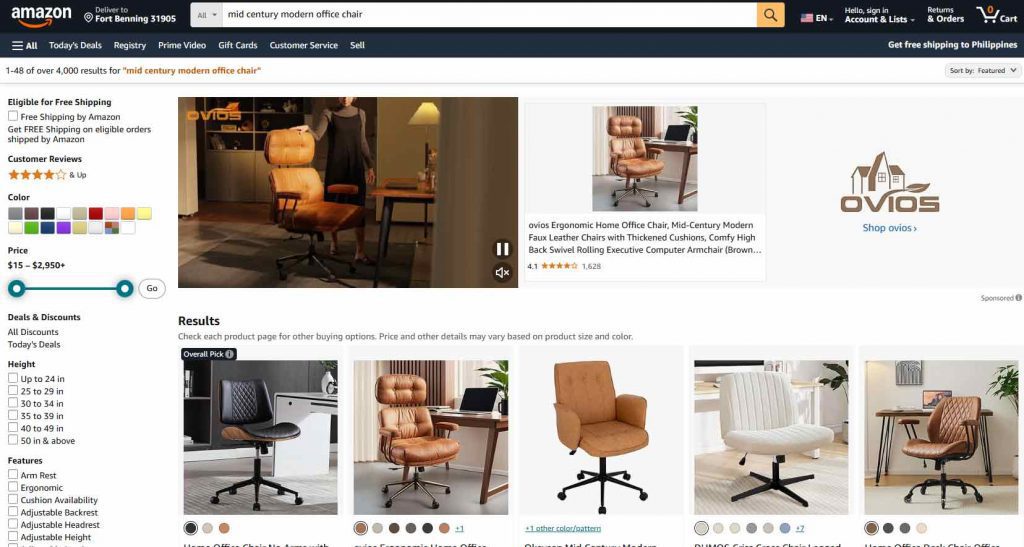
Yes, the internet’s premier shopping destination has a robust collection of mid century modern office chairs. Like with most products, their selection of seats is vast and can be hit or miss. Still, they’ve got stunning chairs available for any style, whether you care about comfort, class, or ergonomics.
MCM office chair examples: IDS Home Modern ($219), Art Leon MCM Swivel ($139)
7) AllModern
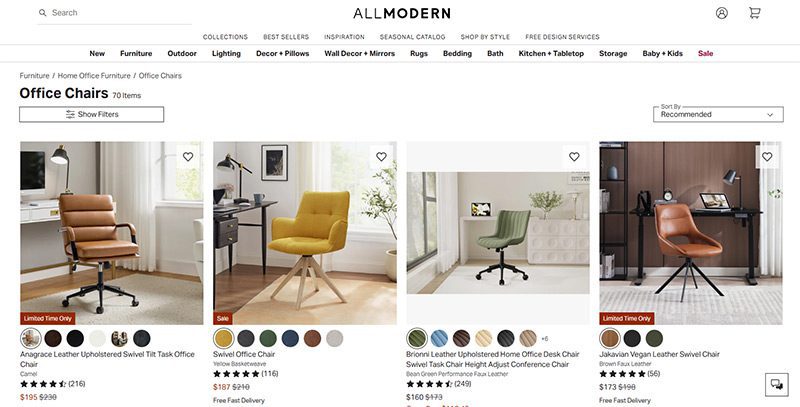
AllModern’s collection of desk chairs and other furniture truly embodies the mid century modern spirit. Their work is tight, angular, and functional above all. They’re part of the Wayfair family and they traffic in a number of modern styles, but their sleek chairs are perfect for any mid century modern space.
MCM office chair examples: Frederick ($229), Kealey ($349)
8) Overstock
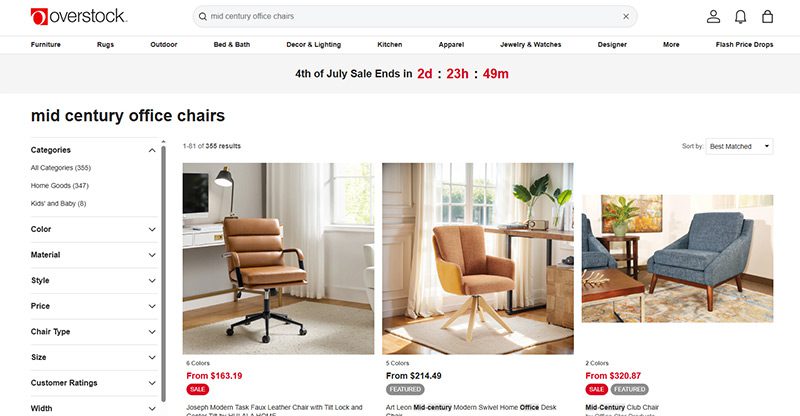
Overstock is known as a one-stop shop for quality home goods at sub-wholesale prices. If you want a spiffy mid century modern office chair that won’t break the bank, they’re the first place to look. While they’re somewhat less reliable than the more upscale platforms on this list, their selection is massive.
MCM office chair example: Joseph Modern ($163)
9) Walmart
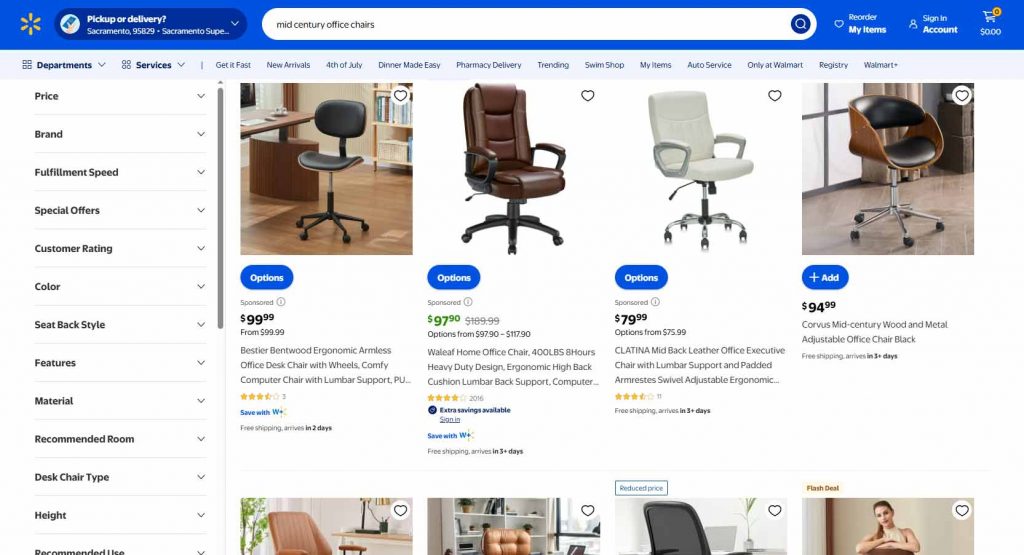
Hayneedle’s selection of mid-century modern office chairs falls somewhere between the minimal Laura Davidson and the endless Amazon catalog. Their array of mid-century designs is affordable and versatile, with chairs that match almost any style. While they may be part of the Walmart family, these chairs are anything but second-rate.
MCM office chair example: Waleaf ($97)
10) Target
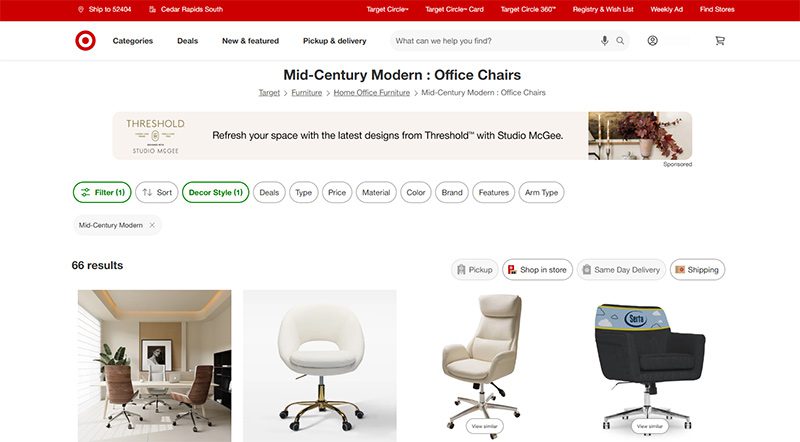
Why splurge when you can save? As usual, Target is a hidden gem, offering a sturdy selection of mid century modern office chairs for some of the cheapest prices out there. Many of the chairs they offer are from the same designers as these other stores—Christopher Knight, LumiSource, Armen Living, etc.—at reduced prices.
MCM office chair example: Lombardi ($136)

A quality payroll service is one of the most invaluable tools any entrepreneur can have. Whether you’re a small business owner or an HR manager, paying your employees on time is crucial. This makes choosing a service even more weighty, after all, it is a heavy administrative burden. The good thing is, you can outsource this duty to an online payroll processor.
According to statistics, 49% of workers begin a new job search after just two paycheck errors, and with 65% of workers living paycheck to paycheck, it’s more important than ever to ensure an efficient, effective payroll process.
These services can save you precious time and mitigate potential issues. To make it easy for you to choose, we listed the best online payroll services for 2025.
Top 5 Online Payroll Services
Gusto
Gusto is a great option for both new and experienced payroll administrators, boasting an incredibly clean user interface and a first-rate payroll setup. Gusto lets you manage your employee’s time off (vacation and sick pay), company health insurance, and worker’s comp. Gusto offers excellent mobile access, too. This allows employees to manage aspects of their Gusto profiles, view payday insights, and access Gusto Wallet financial tools.
Gusto offers four tiers of membership, the most affordable of which is the Contractor’s Only plan, which offers unlimited U.S.-based and global contractor payments, supporting more than 100 countries, plus 1099 creation and filing at a rate of $6 per person per month with no base price.
The other three are Simple, Plus, and Premium. Here’s a deeper look into each plan:
Simple
Price:
$40/mo + $6/mo per person
Plan details:
- Full-service single-state payroll including W-2s and 1099s
- Employee profiles and self-service
- Basic hiring and onboarding tools
- Gusto-brokered health insurance administration
- Employee financial benefits
- Payroll and time-off reports
- Custom admin permissions
- Integrations for accounting, time tracking, expense management, and more
Plus
Price:
$80/mo + $12/mo per person
Plan details:
(All Simple plan features +)
- Full-service multi-state payroll including W-2s and 1099s
- Next-day direct deposit
- Advanced hiring and onboarding tools
- PTO management and policies
- Time tracking and project tracking
- Workforce costing and custom reports
- Team management tools
- Full support
Premium
Price:
Bespoke pricing, reach out for a personalized quote
Plan details:
(All Plus plan features +)
- HR Resource Center
- Compliance alerts
- Access to certified HR experts
- Full-service payroll migration and account setup
- Health insurance broker integration
- R&D tax credit discount
- Waived fees and exclusive pricing
- Performance reviews
- Employee surveys and insights
- Dedicated support
QuickBooks Online Payroll
Founded in 1983, Intuit is a California-based financial software company. Since its inception, Intuit has developed into one of the best-known providers of accounting software. Their online payroll service, QuickBooks, includes the essential features you need to run payroll.
QuickBooks offers three tiers of membership. The least expensive membership covers basic accounting features, such as invoices. For more features, check out the Essentials and Plus memberships. Each plan’s features are as follows:
QuickBooks Simple Start (2025)
- Price: $38/month for 1 user
- Best for: Freelancers and small teams with basic payroll needs
Features:
- Automated bookkeeping
- 5 free ACH bank transfers/mo for bills
QuickBooks Essentials (2025)
- Price: $75/month for 3 users
- Best for: Small businesses needing deeper financial tracking
Features:
- Includes all Simple Start features, plus:
- Recurring invoices
QuickBooks Plus (2025)
- Price: $115/month for 5 users
- Best for: Growing businesses with HR and compliance needs
Features:
- Includes all Essentials features, plus:
- AI-powered profit & loss insights
- Anomaly detection and resolution
- Budgeting
QuickBooks Advanced (2025)
- Price: $275/month for 25 users
- Best for: Established businesses with HR and compliance needs
Features:
- Includes all Plus features, plus:
- Custom user management and permissions
- Custom report builder
- Data sync with Excel
- Revenue recognition
- Forecasting
OnPay
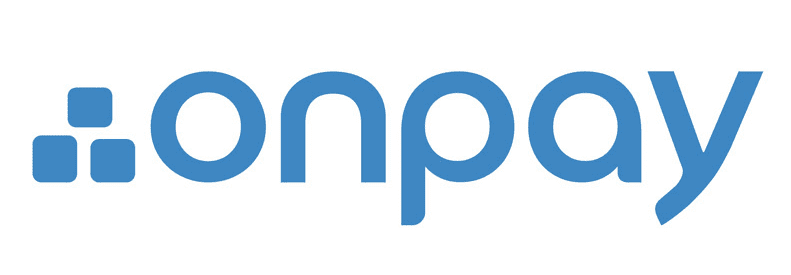
OnPay is a cloud-based full-service payroll processing system capable of running payroll according to a preset schedule, automatically disbursing wages, and calculating and withholding taxes.
OnPay can sync up with several other software your team is already using, making it easy to integrate the service into your team’s system. Another benefit of OnPays model is the simple, transparent pricing structure. No tiers; just one base rate.
Pricing:
$49/mo + $6/mo per employee
SurePayroll

SurePayroll’s award-winning service supports W-2 employees and 1099 contractors. Additionally, it handles 401(k) deductions and manages flexible spending accounts (FSA) and health savings accounts (HSA).
SurePayroll also offers a mobile app— available on both Apple and Android devices.
SurePayroll offers live support through its United States-based support team through chat, email, or phone.
Small Business Payroll
- Price: No Tax Filing: $20/month + $4 per employee, Full Service: $29/month + $7 per employee
- Best for: Small businesses and startups
Features:
- We file and deposit your federal and state taxes!
- Run payroll in 3 simple steps
- Schedule payroll to run automatically
- Unlimited payroll runs and free 2-day direct deposit
- Reports and pay stubs are available online 24/7
- Supports W-2 employees and 1099 contractors
Nanny & Household Payroll
- Price: Full-Service Household, $39/month, includes 1 employee, $10 per additional employee
Best for: Homeowners
Features:
- Signature-ready Schedule H
- We file & deposit your federal and state taxes!
- Run payroll in 3 simple steps
- Schedule payroll to run automatically
- Unlimited payroll runs and free 2-day direct deposit
- Reports & paystubs available online 24/7
- Supports W-2 employees & 1099 contractors
Be sure to choose a payroll service that works for your business, and provides you with the peace of mind that comes with a reliable bookkeeping system. Your employees will thank you.

Merck is currently in talks to acquire Seagen, a biotech company. The Wall Street Journal reports that the transaction is valued at $40 billion. And what happens if Merck acquires Seagen, and how would this acquisition benefit cancer research and treatment? Read more about the Merck Seagen buyout here.
Merck Seagen Buyout
Merck and Seagen are still deciding on their share prices. So far, talks have yet to reach an agreement on $200 per share. Both companies want to settle and finalize their deals before Merck announces its quarterly earnings on July 28. At the time of writing, Seagen’s stock was at $176.19.
With an estimated market value of $235 billion, Merck is looking to expand its presence in the cancer treatment space. The Merck Seagen Buyout could play a major role in that strategy. Since Seagen specializes in targeted cancer therapies, the acquisition would give Merck access to a broader range of oncology products.
Shareholder reactions to the new deal are overwhelmingly positive, and the stocks have been up since talks about the deal have been made public.
But this is not the first time that Merck and Seagen have made the news. Back in 2020, they collaborated because of cancer treatments. Seagen has a drug conjugate (ladiratuzumab vedotin) which would be used in conjunction with Merck’s Keytruda.
Merck reveals that Keytruda is its highest-selling product. It’s immunotherapy for cancer.
And this deal could help Merck offset the possibility of reduced sales because it will lose patent protection in 2028.
As promising as this deal is, there could be scrutiny from antitrust officials since there might be a litigation case from the Federal Trade Commission or Justice Department.
The Seagen buyout isn’t the only deal Merck has made recently. They’ve been busy closing another deal, but with Orion too.
Seagen
As a cancer biotech company, Seagen has therapies to ensure that patients benefit from the treatment and reduce any adverse side effects. Their treatments involve the therapy attacking tumors with toxins.
Merck partnering with Seagen isn’t a bad idea considering that Seagen made $1.4 billion in sales in 2021, most of it coming from Adcetris and Padcev (a treatment for urothelial cancers).
Merck-Orion Deal
In the middle of the Merck Seagen Buyout, Merck has recently partnered with Orion for the ODM-208 and other drugs. These drugs are related to the production of steroids. Orion found how it can combat hormone-dependent cancers and further developed this inhibitor.
Their deal includes that they should develop ODM-208 and promote it to the public together. And Orion will receive a $290 million payment from Merck.
Although they’re co-developing and marketing the new inhibitor, Orion will oversee the manufacturing side.
Co-developing the ODM-208 can help Merck with its current research and treatments for prostate cancer. President and CEO of Orion, Timo Lappalainen, says that this partnership will benefit Merck’s goals of treating cancer worldwide.
Other Ventures: Merck’s Role in the Pandemic
You may have heard about COVID-19 pills, which are a form of treatment for those diagnosed with mild to moderate COVID-19. Merck introduced an antiviral COVID-19 pill to the public. The name: Molnupiravir.
The COVID-19 pill is not a replacement for a vaccination. Instead, it stops the replication of the COVID-19 genetic code and keeps the patient out of the hospital. Not yet FDA-approved, Molnupiravir has been authorized for emergency use since December 23, 2021.
And for other stories, read more here at Owner’s Mag!

What Is Tiktok Pink Sauce? The Viral Condiment, Explained

Did You Drop Your Smartphone in The Ocean? Here’s How to Retrieve It

Gift Guide: 25 Best Gifts for Women for All Occasions

History of the NBA: The Success Behind the Big League

Demio SaaS 2025 Review: Features, Pricing, Pros & Cons

Top 12 Uses for The Metaverse That Will Change Your Life

Top 10 Best Places to Buy a Mid Century Modern Office Chair

Top 10 Best Places to Buy a Mid Century Modern Office Chair

History of the NBA: The Success Behind the Big League

8 Best Equipment for YouTube Every Content Creator Needs

Demio SaaS 2025 Review: Features, Pricing, Pros & Cons

Did You Drop Your Smartphone in The Ocean? Here’s How to Retrieve It

Top 10 Small Business Organization Tools for 2025

Top 12 Uses for The Metaverse That Will Change Your Life
Trending
- Entertainment5 days ago
History of the NBA: The Success Behind the Big League
- Lifestyle4 days ago
Did You Drop Your Smartphone in The Ocean? Here’s How to Retrieve It
- Lifestyle5 days ago
Gift Guide: 25 Best Gifts for Women for All Occasions
- Top Stories4 days ago
What Is Tiktok Pink Sauce? The Viral Condiment, Explained
















